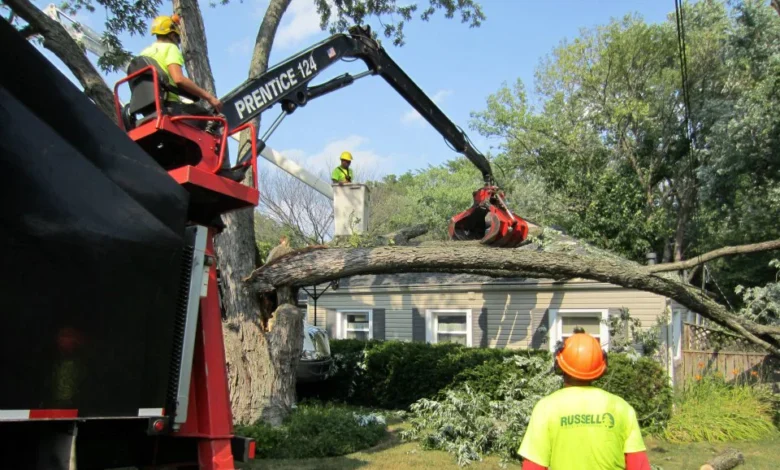How Regular Tree Maintenance Prevents Storm Damage and Property Risk

Picture this: A strong storm rolls through your neighborhood at night. You wake up to find a massive tree branch crashed through your roof. Your car sits crushed in the driveway. Power lines are down across the street. This nightmare happens to thousands of homeowners every year. The worst part? Most of this damage could have been prevented with simple tree care. Trees add beauty and value to your property, but without proper maintenance, they become serious risks during storms. In this article, you’ll learn how regular tree maintenance protects your home, saves you money, and keeps your family safe when bad weather strikes.
Why Trees Fail During Storms
Trees don’t just fall over randomly during storms. There are clear reasons why some trees survive while others cause massive damage.
Common Causes of Tree Failure
Dead or diseased branches are the first to break when wind picks up. These weak spots can’t handle the stress of a storm. Trees with shallow or damaged root systems struggle to stay upright when soil gets saturated with rain. Dense, overgrown canopies act like giant sails, catching wind and putting huge pressure on the trunk. Poor pruning cuts from years ago create weak points where branches split away. All of these problems build up over time until one strong storm brings everything crashing down.
The Real Cost of Tree Damage
When a tree fails during a storm, the damage adds up fast. A single fallen tree can destroy a roof, costing tens of thousands to repair. Branches can total your vehicles or smash through fences. People get seriously hurt or even killed by falling trees and limbs. Downed trees knock out power lines, leaving entire neighborhoods in the dark for days. Your homeowner’s insurance might cover some costs, but rates often go up after claims. If your tree damages a neighbor’s property, you could face liability issues. The financial and emotional toll is enormous.
How Regular Pruning Reduces Storm Risk
The single best way to protect your property from storm damage is regular professional pruning. This isn’t just about making trees look nice. It’s about creating a structure that can handle high winds and heavy weather.
Removing Dead and Weak Branches
Dead wood breaks first when storms hit. These branches have no flexibility and snap like twigs in strong wind. Weak branches with narrow, tight angles where they attach to the trunk are also prime candidates for failure. Professional tree services can spot these problems before they become dangerous. Experts from Tree Services Melbourne explain that trained arborists identify hidden risks that property owners often miss, removing problem branches before they can cause damage during the next storm.
Thinning the Canopy
A thick, dense tree canopy might look healthy, but it’s actually a major storm hazard. Dense foliage catches wind like a parachute, creating massive force on the trunk and roots. Proper canopy thinning reduces this wind resistance dramatically. When you thin a canopy correctly, wind can pass through the tree instead of pushing against it. This technique also balances the weight distribution across branches. The tree becomes more flexible and better able to bend with the wind instead of breaking or toppling over.
Improving Tree Structure
Many trees develop structural problems as they grow. Co-dominant stems, where the tree has two or more main trunks, create weak points that split apart in storms. Branches that cross and rub against each other wear down the bark and create entry points for disease. Professional pruning corrects these issues early. Arborists create a stronger framework by selecting the best branches and removing problems. This guides the tree to grow in a way that’s naturally more stable and storm-resistant. The investment you make in structural pruning today prevents expensive emergency tree removal later.
Tree Health Care Strengthens Storm Resistance
Pruning is just one part of tree maintenance. Keeping your trees healthy makes them much stronger when storms arrive.
Building Stronger Root Systems
Roots are your tree’s anchor system. A tree is only as stable as its roots. Proper fertilization gives trees the nutrients they need to grow deep, strong root systems. Quality mulch around the base retains moisture and protects roots from temperature extremes. When roots are healthy and well-established, trees can withstand incredible wind forces. They’re far less likely to topple over, even in saturated soil conditions. Regular watering during dry periods also keeps root systems strong and extensive.
Disease and Pest Management
Diseases eat away at a tree’s structural integrity from the inside. Wood-boring insects create hollow chambers that weaken trunks and branches. Fungal infections cause rot that you can’t see until it’s too late. By the time visible symptoms appear, serious damage has already occurred. Regular inspections catch these problems early when treatment is still effective. Healthy trees also recover faster from minor storm damage. They can seal wounds and grow stronger after losing branches, while diseased trees continue to decline.
Signs Your Trees Need Professional Attention
You don’t need to be an expert to spot warning signs. Watch for these red flags that indicate your trees need professional care right away.
Trees that lean to one side, especially if the lean is getting worse, are at high risk of falling. Exposed roots on one side of a tree mean the anchor system is failing. Dead branches in the upper canopy are sometimes called “widow makers” because they fall without warning. Dense, overgrown foliage that hasn’t been pruned in years catches too much wind. Branches hanging over your roof or touching power lines are accidents waiting to happen. Visible cracks, splits, or cavities in the trunk are serious structural problems. Mushrooms or fungus growing on the trunk indicate internal rot. If your trees suffered damage in a previous storm, that damage often leads to more problems if left untreated.
When to Schedule Tree Maintenance
Timing matters when it comes to tree care. Most trees should be pruned during their dormant season, typically late fall through early winter. Trees heal faster when they’re not actively growing. Mature trees benefit from professional pruning every three to five years, though some species need more frequent attention. Don’t wait until storm season arrives to start thinking about tree maintenance. Trees need time to heal and stabilize after major pruning work. Regular inspections catch developing problems before they become emergencies. Make tree care a routine part of your property maintenance, just like HVAC servicing or roof inspections.
Why Professional Tree Care Matters
Some homeowners try to save money by doing their own tree work. This is almost always a mistake, especially for large trees or anything near power lines.
Tree work is one of the most dangerous jobs in the world. Professional arborists have years of training and specialized equipment to do the work safely. They understand tree biology and how different species respond to pruning. Certified arborists can spot hidden problems like internal decay, dangerous branch attachments, and disease symptoms. Poor pruning techniques actually make trees more dangerous, creating weak points that fail in the next storm. You also take on serious liability if someone gets hurt or property gets damaged during DIY tree work. Professional tree services carry insurance and take responsibility for the work they do.
Conclusion
Storm damage from trees is not just bad luck. It’s usually the result of years of neglect. Regular tree maintenance is your best protection against property damage, injury, and financial loss when bad weather strikes. Professional pruning removes weak branches, thins dense canopies, and creates stronger tree structures. Health care builds robust root systems and fights disease before it weakens your trees. The cost of routine maintenance is tiny compared to the thousands you’ll spend repairing storm damage or removing a fallen tree from your home. Don’t wait for disaster to strike. Schedule a professional tree inspection before the next storm season arrives. Your property, your family, and your wallet will all be safer for it.



